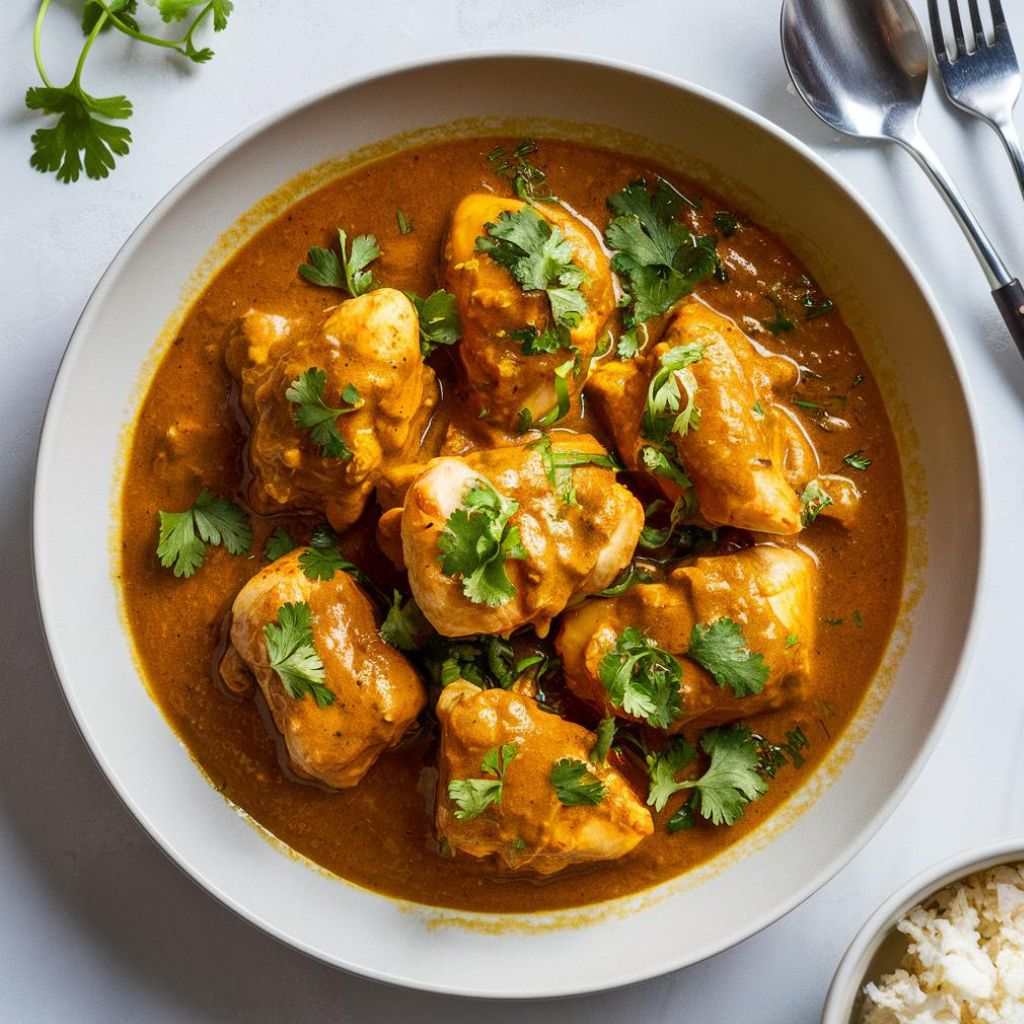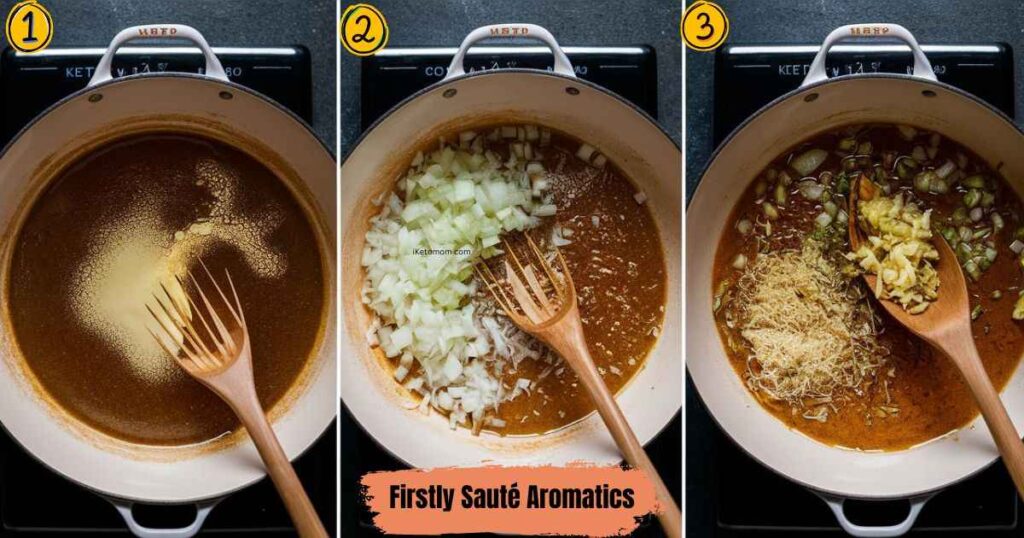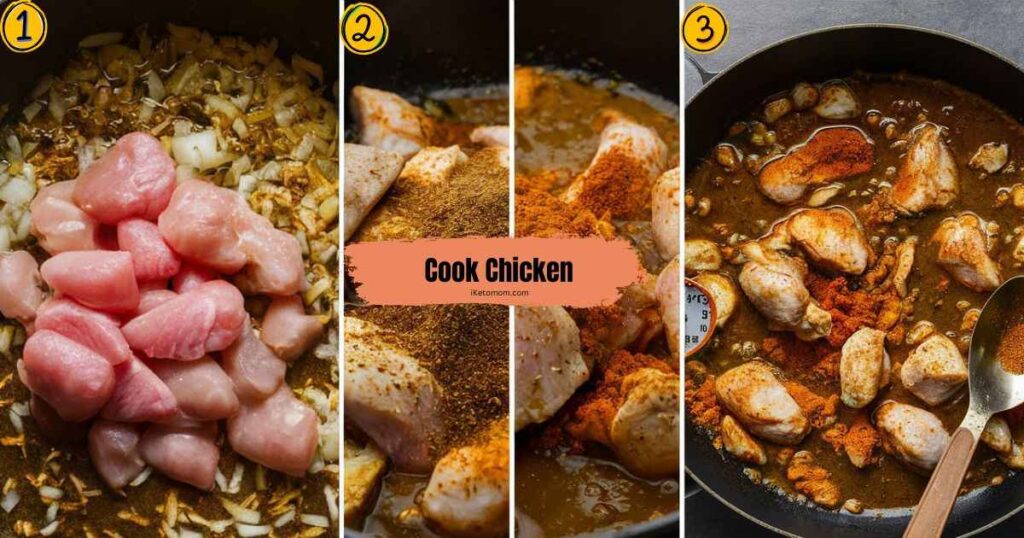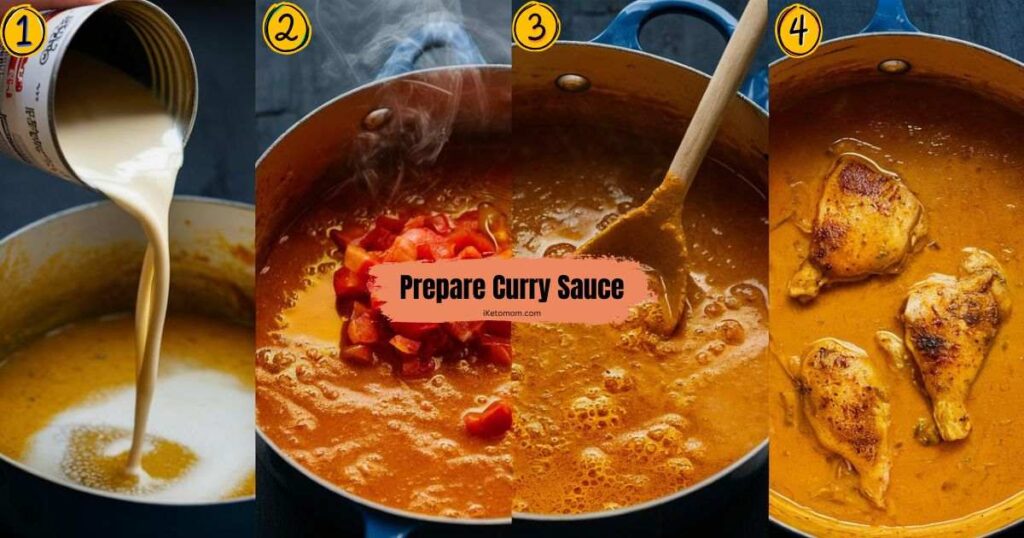Keto Chicken Curry is a flavorful and satisfying dish that combines the aromatic spices of traditional curry with the dietary principles of the ketogenic lifestyle. This dish features tender chicken simmered in a rich, creamy sauce made from coconut milk, garlic, ginger, and a blend of spices such as turmeric, cumin, and coriander. The result is a curry that’s both hearty and comforting, yet perfectly aligned with low-carb and keto dietary guidelines.
The ketogenic diet focuses on high-fat, moderate-protein, and very low-carb intake to encourage the body to enter a state of ketosis, where it burns fat for fuel instead of carbohydrates. By minimizing carb consumption and increasing healthy fats, the keto diet can aid in weight management, support stable blood sugar levels, and promote overall energy and mental clarity.
Keto Chicken Curry is an excellent low-carb option because it substitutes high-carb ingredients with keto-friendly alternatives. Using coconut milk instead of cream or dairy keeps the recipe within keto guidelines while adding a rich texture and flavor. Additionally, the absence of starchy vegetables and the careful selection of spices ensures that the dish remains low in carbs without sacrificing taste. This makes it an ideal meal for those looking to enjoy a delicious curry while adhering to a ketogenic diet.
Keto Chicken Curry Recipe
Ingredients
- Chicken:
- Amount: 1.5 pounds
- Type: Boneless, skinless
- Preparation: Cut into bite-sized pieces
- Purpose: Provides the main protein source and absorbs the flavors of the curry sauce.
- Coconut Oil or Ghee:
- Amount: 2 tablespoons
- Type: Coconut oil or clarified butter (ghee)
- Purpose: Used for sautéing aromatics and adds a rich, slightly nutty flavor.
- Onion:
- Amount: 1 medium
- Preparation: Finely chopped
- Purpose: Adds sweetness and depth of flavor to the curry base.
- Garlic:
- Amount: 3 cloves
- Preparation: Minced
- Purpose: Provides a pungent, aromatic flavor that enhances the overall taste of the curry.
- Ginger:
- Amount: 1 tablespoon
- Preparation: Freshly grated
- Purpose: Adds a warm, spicy note and complements the garlic.
- Turmeric:
- Amount: 1 teaspoon
- Type: Ground
- Purpose: Provides a vibrant yellow color and earthy flavor; has anti-inflammatory properties.
- Ground Cumin:
- Amount: 1 teaspoon
- Purpose: Adds a warm, nutty flavor that complements other spices in the curry.
- Ground Coriander:
- Amount: 1 teaspoon
- Purpose: Offers a citrusy and slightly sweet flavor that balances the spices.
- Paprika:
- Amount: 1 teaspoon
- Purpose: Adds a mild heat and enhances the color of the curry.
- Canned Coconut Milk:
- Amount: 1 can (13.5 ounces)
- Type: Full-fat coconut milk
- Purpose: Creates a creamy and rich sauce, adding a subtle coconut flavor.
- Diced Tomatoes:
- Amount: 1 can (14.5 ounces)
- Type: Canned, or alternatively, Tomato Paste: 2 tablespoons (for a lower carb option)
- Purpose: Provides acidity and a slightly sweet flavor; the tomato paste will give a thicker consistency and a richer flavor.
- Salt:
- Amount: 1 teaspoon (or to taste)
- Purpose: Enhances the overall flavor of the dish.
- Black Pepper:
- Amount: 1/2 teaspoon (or to taste)
- Purpose: Adds a subtle heat and complexity to the flavor profile.
- Fresh Cilantro:
- Amount: 2 tablespoons
- Preparation: Chopped
- Purpose: Used as a garnish to add a fresh, bright flavor to the finished curry.
Optional Ingredients:
- Bell Peppers:
- Amount: 1 cup
- Preparation: Diced
- Purpose: Adds color, crunch, and additional flavor.
- Spinach:
- Amount: 1 cup
- Preparation: Fresh, chopped or whole leaves
- Purpose: Adds nutrients and a mild, earthy flavor.
Instructions
1. Sauté Aromatics:
-
- Heat coconut oil or ghee in a large skillet or Dutch oven over medium heat. Add the finely chopped onion and cook until translucent, about 5 minutes. Stir in the minced garlic and freshly grated ginger, cooking for an additional 1-2 minutes until fragrant.
2. Cook Chicken:
-
- Add the chicken pieces to the skillet. Season with turmeric, ground cumin, ground coriander, and paprika. Cook, stirring occasionally, until the chicken is browned on all sides, about 5-7 minutes.
3. Prepare Curry Sauce:
-
- Pour in the coconut milk and diced tomatoes (or tomato paste). Stir well to combine. Bring the mixture to a simmer, then reduce the heat to low. Cover and cook for 15-20 minutes, or until the chicken is cooked through and tender.
4. Finish and Serve:
-
- Taste and adjust seasoning with salt and black pepper as needed. Garnish with fresh chopped cilantro if desired. Serve hot over cauliflower rice or with your preferred keto-friendly side. Enjoy your flavorful Keto Chicken Curry!
Also, try: Keto Tuscan Chicken, Keto Fried Chicken, Keto Butter Chicken, Keto Crockpot Crack Chicken, Keto Chicken Salad Recipe
Once you’ve served your Keto Chicken Curry over cauliflower rice or your preferred side, savor the rich, aromatic flavors of this comforting dish. Whether for a weeknight dinner or a special occasion, this curry provides a satisfying, low-carb option that aligns perfectly with your keto lifestyle. Enjoy the blend of spices and creamy sauce, and feel free to experiment with additional veggies or spice levels to suit your taste.
Keto Chicken Curry is a delicious and hearty dish designed to fit seamlessly into a ketogenic diet. Featuring tender pieces of chicken simmered in a creamy coconut milk sauce, this curry is infused with aromatic spices such as turmeric, cumin, coriander, and paprika. The result is a rich, flavorful meal that satisfies cravings while maintaining low-carb integrity. By using coconut milk instead of cream and avoiding starchy vegetables, this recipe delivers all the comforting elements of traditional curry without derailing your keto goals.
Not only does Keto Chicken Curry offer a tasty alternative to higher-carb meals, but it also supports the benefits of a keto diet, including improved weight management and stable blood sugar levels. The dish can be easily customized with optional vegetables like bell peppers or spinach for added nutrition. Perfect for both everyday dinners and special occasions, this curry is a versatile, nutritious option that ensures you can enjoy bold flavors while staying within your dietary guidelines.
Keto Chicken Curry Nutrition Info
Nutrition Table for Keto Chicken Curry (Per Serving)
| Nutrient | Amount |
| Calories | 300-400 kcal |
| Protein | 25-30 g |
| Total Fat | 20-30 g |
| Saturated Fat | 10-15 g |
| Total Carbohydrates | 8-12 g |
| Dietary Fiber | 2-4 g |
| Sugars | 4-6 g |
| Sodium | 500-700 mg |
| Cholesterol | 80-100 mg |
Note: These values are approximate and can vary based on specific ingredient brands and portion sizes. For precise nutritional information, consider using a detailed nutritional calculator or app with the exact ingredients used.
Here’s a consolidated nutrition table for each ingredient used in Keto Chicken Curry:
| Ingredient | Amount | Calories | Protein | Total Fat | Saturated Fat | Total Carbohydrates | Dietary Fiber | Sugars | Sodium |
|---|---|---|---|---|---|---|---|---|---|
| Chicken | 1.5 pounds (about 3 cups) | 600 kcal | 90 g | 30 g | 7.5 g | 0 g | 0 g | 0 g | 150 mg |
| Coconut Oil | 2 tablespoons | 240 kcal | 0 g | 28 g | 25 g | 0 g | 0 g | 0 g | 0 mg |
| Onion | 1 medium | 44 kcal | 1 g | 0.1 g | 0 g | 10 g | 1.5 g | 5 g | 2 mg |
| Garlic | 3 cloves | 13 kcal | 0.6 g | 0 g | 0 g | 3 g | 0.2 g | 0.1 g | 1 mg |
| Ginger | 1 tablespoon | 5 kcal | 0.1 g | 0 g | 0 g | 1 g | 0.2 g | 0.2 g | 0 mg |
| Turmeric | 1 teaspoon | 8 kcal | 0.2 g | 0.2 g | 0 g | 1.4 g | 0.3 g | 0 g | 2 mg |
| Ground Cumin | 1 teaspoon | 8 kcal | 0.4 g | 0.5 g | 0.2 g | 0.9 g | 0.5 g | 0.2 g | 1 mg |
| Ground Coriander | 1 teaspoon | 5 kcal | 0.2 g | 0.3 g | 0.1 g | 1 g | 0.5 g | 0.1 g | 0 mg |
| Paprika | 1 teaspoon | 6 kcal | 0.3 g | 0.3 g | 0.1 g | 1 g | 0.6 g | 0.1 g | 1 mg |
| Coconut Milk | 1 can (13.5 ounces) | 445 kcal | 5 g | 48 g | 43 g | 6 g | 0 g | 6 g | 10 mg |
| Diced Tomatoes | 1 can (14.5 ounces) | 70 kcal | 3 g | 0.5 g | 0 g | 15 g | 4 g | 10 g | 400 mg |
| Tomato Paste | 2 tablespoons | 30 kcal | 1 g | 0 g | 0 g | 7 g | 1 g | 4 g | 10 mg |
| Salt | 1 teaspoon | 0 kcal | 0 g | 0 g | 0 g | 0 g | 0 g | 0 g | 2300 mg |
| Black Pepper | 1/2 teaspoon | 3 kcal | 0.1 g | 0.1 g | 0 g | 1 g | 0.6 g | 0 g | 0 mg |
| Fresh Cilantro | 2 tablespoons | 1 kcal | 0.1 g | 0 g | 0 g | 0.2 g | 0.1 g | 0.1 g | 0 mg |
This table provides an approximate nutritional breakdown for each ingredient used in Keto Chicken Curry. The total nutritional values of the dish will depend on the specific quantities and portion sizes.
Tips for Best Results
- Use Fresh Spices: For the most vibrant and flavorful curry, use fresh spices or grind whole spices yourself. This will enhance the aromatic quality of the curry and give it a richer taste.
- Adjust Spice Levels: Tailor the spice levels to your preference by adjusting the amount of turmeric, cumin, coriander, and paprika. If you prefer a milder curry, start with smaller amounts and increase gradually.
- Marinate the Chicken: For deeper flavor, marinate the chicken pieces in a mixture of some of the spices, garlic, and ginger for at least 30 minutes before cooking. This helps the flavors penetrate the chicken more effectively.
- Cook on Low Heat: Simmer the curry on low heat to allow the flavors to meld together and ensure the chicken remains tender. Avoid high heat, which can make the sauce separate or cause the chicken to become tough.
- Use Full-Fat Coconut Milk: Opt for full-fat coconut milk for a creamier and richer curry. Light coconut milk may not provide the same depth of flavor or texture.
- Add Vegetables for Extra Nutrition: Consider adding keto-friendly vegetables like bell peppers, spinach, or zucchini. These not only boost the nutritional profile but also add extra texture and flavor to the dish.
- Taste and Adjust Seasoning: Always taste the curry before serving and adjust the seasoning as needed. A touch more salt or a squeeze of lime juice can make a big difference in flavor.
- Garnish for Freshness: Garnish the curry with fresh cilantro just before serving to add a burst of freshness and a pop of color.
- Pair with a Low-Carb Side: Serve the curry with cauliflower rice or a side of steamed green vegetables to keep the meal low-carb and satisfying.
- Storage and Reheating: Store leftovers in an airtight container in the refrigerator for up to 3 days. Reheat gently on the stovetop to prevent curdling of the coconut milk. The curry can also be frozen for up to 2 months; thaw overnight in the refrigerator before reheating.

Keto Chicken Curry Recipe
Equipment
- Large Skillet or Dutch Oven
- Cutting board
- Sharp knife
- Sharp knife
- Measuring cups
- Wooden spoon or spatula
- Can opener
- Serving dishes:
- Blender or Food Processor(Optional)
Ingredients
- 1.5 Pounds Chicken (boneless, skinless, cut into bite-sized pieces)
- 2 Tablespoons Coconut Oil or Ghee
- 1 Medium Onion(Chopped)
- 3 Cloves Garlic
- 1 Tablespoon Ginger
- 1 Teaspoon Turmeric
- 1 Teaspoon Ground Cumin
- 1 Teaspoon Ground Coriander
- 1 Teaspoon Paprika
- 13.5 Ounces Canned Coconut Milk
- 1 Can Diced Tomatoes
- 1 Teaspoon Salt
- 1/2 Teaspoon Black Pepper
- 2 Teaspoon Fresh Cilantro
Optional:
- 1 Cup Bell Peppers (diced, for added vegetables)
- 1 Cup Spinach (fresh, for added greens)
Instructions
- Heat Oil: In a large skillet or Dutch oven, heat coconut oil or ghee over medium heat.
- Sauté Aromatics: Cook chopped onion until translucent, then add minced garlic and grated ginger, cooking for 1-2 minutes.
- Add Chicken: Stir in chicken pieces and season with turmeric, cumin, coriander, and paprika. Cook until chicken is browned.
- Add Liquids: Pour in coconut milk and diced tomatoes (or tomato paste). Stir well.
- Simmer: Bring to a simmer, cover, and cook for 15-20 minutes, or until the chicken is cooked through.
- Season and Serve: Adjust seasoning with salt and pepper. Garnish with fresh cilantro and serve over cauliflower rice or with your preferred keto side.
Notes
Delicious Topping Ideas

I’m Priscilla Swahn, a registered dietitian with a master’s degree in nutritional sciences. With over a decade of experience in holistic nutrition, I specialize in creating delicious keto recipes to help you enjoy a healthy lifestyle. On iKetoMom, you’ll find a variety of recipes for every meal—hearty breakfasts, satisfying lunches, mouthwatering dinners, indulgent desserts, and refreshing drinks. My recipes make keto living easy and enjoyable for the whole family. Featured in EatingWell and MindBodyGreen, I also collaborate with health centers and corporate companies to share my expertise. Join me and discover the joy of keto cooking!






